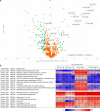The deep-subsurface sulfate reducer Desulfotomaculum kuznetsovii employs two methanol-degrading pathways
- PMID: 29339722
- PMCID: PMC5770442
- DOI: 10.1038/s41467-017-02518-9
The deep-subsurface sulfate reducer Desulfotomaculum kuznetsovii employs two methanol-degrading pathways
Abstract
Methanol is generally metabolized through a pathway initiated by a cobalamine-containing methanol methyltransferase by anaerobic methylotrophs (such as methanogens and acetogens), or through oxidation to formaldehyde using a methanol dehydrogenase by aerobes. Methanol is an important substrate in deep-subsurface environments, where thermophilic sulfate-reducing bacteria of the genus Desulfotomaculum have key roles. Here, we study the methanol metabolism of Desulfotomaculum kuznetsovii strain 17T, isolated from a 3000-m deep geothermal water reservoir. We use proteomics to analyze cells grown with methanol and sulfate in the presence and absence of cobalt and vitamin B12. The results indicate the presence of two methanol-degrading pathways in D. kuznetsovii, a cobalt-dependent methanol methyltransferase and a cobalt-independent methanol dehydrogenase, which is further confirmed by stable isotope fractionation. This is the first report of a microorganism utilizing two distinct methanol conversion pathways. We hypothesize that this gives D. kuznetsovii a competitive advantage in its natural environment.
Conflict of interest statement
The authors declare no competing financial interests.
Figures





Similar articles
-
Cobalt modulates methanol turnover of the alcohol dehydrogenase in Desulfofundulus kuznetsovii strain TPOSR.Appl Environ Microbiol. 2025 May 21;91(5):e0021525. doi: 10.1128/aem.00215-25. Epub 2025 Apr 9. Appl Environ Microbiol. 2025. PMID: 40202321 Free PMC article.
-
Alcohol dehydrogenase system acts as the sole pathway for methanol oxidation in Desulfofundulus kuznetsovii strain TPOSR.Antonie Van Leeuwenhoek. 2024 Mar 1;117(1):47. doi: 10.1007/s10482-024-01937-1. Antonie Van Leeuwenhoek. 2024. PMID: 38427176 Free PMC article.
-
Methanol utilization in defined mixed cultures of thermophilic anaerobes in the presence of sulfate.FEMS Microbiol Ecol. 2004 Sep 1;49(3):489-94. doi: 10.1016/j.femsec.2004.05.004. FEMS Microbiol Ecol. 2004. PMID: 19712297
-
Methylotrophs and Methylotroph Populations for Chloromethane Degradation.Curr Issues Mol Biol. 2019;33:149-172. doi: 10.21775/cimb.033.149. Epub 2019 Jun 5. Curr Issues Mol Biol. 2019. PMID: 31166190 Review.
-
Desulfotomaculum spp. and related gram-positive sulfate-reducing bacteria in deep subsurface environments.Front Microbiol. 2013 Dec 2;4:362. doi: 10.3389/fmicb.2013.00362. eCollection 2013. Front Microbiol. 2013. PMID: 24348471 Free PMC article. Review.
Cited by
-
Patterns of in situ Mineral Colonization by Microorganisms in a ~60°C Deep Continental Subsurface Aquifer.Front Microbiol. 2020 Nov 19;11:536535. doi: 10.3389/fmicb.2020.536535. eCollection 2020. Front Microbiol. 2020. PMID: 33329414 Free PMC article.
-
Cobalt modulates methanol turnover of the alcohol dehydrogenase in Desulfofundulus kuznetsovii strain TPOSR.Appl Environ Microbiol. 2025 May 21;91(5):e0021525. doi: 10.1128/aem.00215-25. Epub 2025 Apr 9. Appl Environ Microbiol. 2025. PMID: 40202321 Free PMC article.
-
Basalt-Hosted Microbial Communities in the Subsurface of the Young Volcanic Island of Surtsey, Iceland.Front Microbiol. 2021 Sep 29;12:728977. doi: 10.3389/fmicb.2021.728977. eCollection 2021. Front Microbiol. 2021. PMID: 34659155 Free PMC article.
-
A ubiquitous and diverse methanogenic community drives microbial methane cycling in eutrophic coastal sediments.FEMS Microbiol Ecol. 2025 Jul 14;101(8):fiaf075. doi: 10.1093/femsec/fiaf075. FEMS Microbiol Ecol. 2025. PMID: 40650567 Free PMC article.
-
Alcohol dehydrogenase system acts as the sole pathway for methanol oxidation in Desulfofundulus kuznetsovii strain TPOSR.Antonie Van Leeuwenhoek. 2024 Mar 1;117(1):47. doi: 10.1007/s10482-024-01937-1. Antonie Van Leeuwenhoek. 2024. PMID: 38427176 Free PMC article.
References
-
- Gniese C, et al. Relevance of deep-subsurface microbiology for underground gas storage and geothermal energy production. Adv. Biochem. Eng. Biotechnol. 2014;142:95–121. - PubMed
Publication types
MeSH terms
Substances
Grants and funding
LinkOut - more resources
Full Text Sources
Other Literature Sources
Molecular Biology Databases

